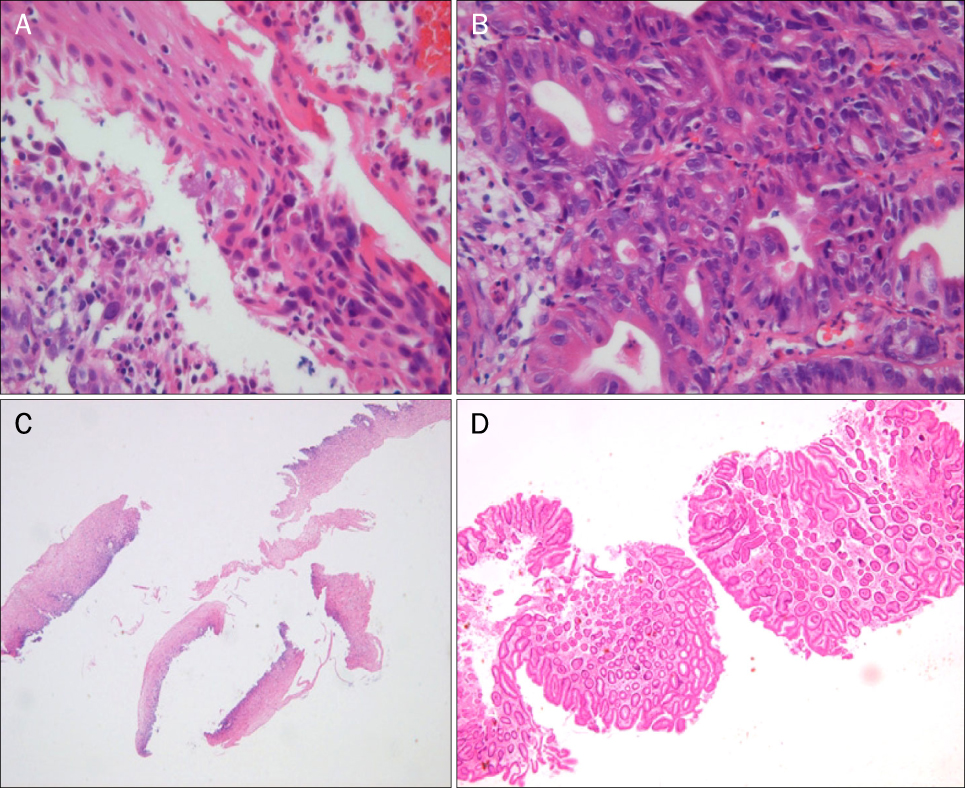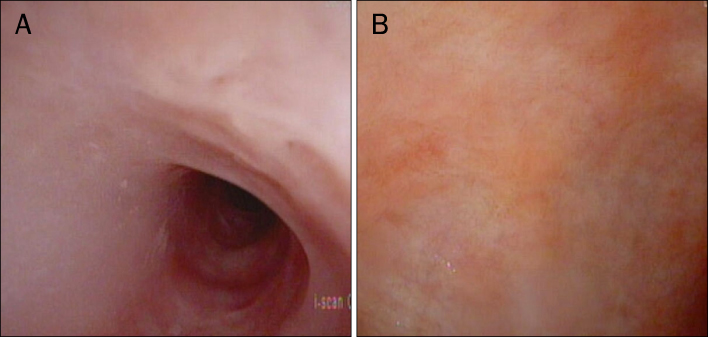Korean J Gastroenterol.
2012 Aug;60(2):113-118. 10.4166/kjg.2012.60.2.113.
A Case of Synchronous Esophagus and Stomach Cancer Successfully Treated by Combined Chemotherapy
- Affiliations
-
- 1Department of Gastroenterology, Dong-A University College of Medicine, Busan, Korea. sychoi@dau.ac.kr
- 2Department of Pathology, Dong-A University College of Medicine, Busan, Korea.
- KMID: 1387340
- DOI: http://doi.org/10.4166/kjg.2012.60.2.113
Abstract
- Although cases of simultaneous esophagus and stomach cancer have been reported sporadically, there are rare reports of successful treatment using chemotherapy. We report a case of synchronous esophageal and gastric cancer successfully treated using docetaxel and cis-diammineedichloro-platinum (CDDP) combination chemotherapy instead of surgery. A 82-years-old man with anorexia and progressive weight loss was diagnosed with synchronous esophageal and gastric cancer by endoscopy. Both cancers were diagnosed as resectable by the preoperative clinical staging. However, surgery was contraindicated because of severe lung dysfunction. Moreover, he actively refused radiotherapy and endoscopic management. Therefore, the patient was given combined chemotherapy with docetaxel (65 mg/m2) and CDDP (60 mg/m2). The esophageal and gastric lesion completely disappeared on endoscopy, and there were no residual tumor cells on endoscopic biopsy after three cycles of chemotherapy. Metastatic lymph nodes also completely disappeared on the CT scan. The patient received a total of ten cycles of chemotherapy, without severe adverse effects. The patient remained asymptomatic for 18 months after discontinuation of the chemotherapy, without evidence of local recurrence or distant metastasis. Surgery or endoscopic treatment of both esophageal and gastric cancers is desirable, but, if medically inoperable, chemotherapy can be alternative treatment option.
MeSH Terms
-
Aged, 80 and over
Antineoplastic Agents/therapeutic use
Cisplatin/therapeutic use
Drug Therapy, Combination
Endoscopy, Digestive System
Esophageal Neoplasms/complications/*drug therapy/pathology
Humans
Male
Positron-Emission Tomography
Stomach Neoplasms/complications/*drug therapy/pathology
Taxoids/therapeutic use
Tomography, X-Ray Computed
Figure
Reference
-
1. Goodner JT, Watson WL. Cancer of the esophagus; its association with other primary cancers. Cancer. 1956. 9:1248–1252.2. Shibuya H, Wakita T, Nakagawa T, Fukuda H, Yasumoto M. The relation between an esophageal cancer and associated cancers in adjacent organs. Cancer. 1995. 76:101–105.3. Koide N, Yazawa K, Koike S, Adachi W, Amano J. Oesophageal cancer associated with other primary cancers: a study of 31 patients. J Gastroenterol Hepatol. 1997. 12:690–694.4. Pasławski M, Złomaniec J, Rucińska E, Kołtyś W. Synchronous primary esophageal and gastric cancers. Ann Univ Mariae Curie Sklodowska Med. 2004. 59:406–410.5. Kato H, Tachimori Y, Watanabe H, et al. Esophageal carcinoma simultaneously associated with gastric carcinoma: analysis of clinicopathologic features and treatments. J Surg Oncol. 1994. 56:122–127.6. Kato H, Iizuka T, Watanabe H, et al. Esophageal cancer associated with gastric cancer. Jpn J Clin Oncol. 1981. 11:315–320.7. Koide N, Adachi W, Koike S, Watanabe H, Yazawa K, Amano J. Synchronous gastric tumors associated with esophageal cancer: a retrospective study of twenty-four patients. Am J Gastroenterol. 1998. 93:758–762.8. Ando N, Niwa Y, Ohmiya N, Ito B, Sasaki Y, Goto H. Simultaneous multiple early cancers of esophagus and stomach treated by endoscopic mucosal resection. Endoscopy. 2002. 34:667–669.9. Yano K, Yamashita T, Chishiki M, Osaki T, Sugio K, Yasumoto K. Two cases of synchronous superficial double cancers in the esophagus and stomach. J UOEH. 2002. 24:225–232.10. Yasumura T, Maruyama T, Kaji S, Yagawa A, Ozawa T. Complete response in a case of advanced esophageal and gastric double cancer treated by chemotherapy of TS-1 and low-dose cisplatin. Gan To Kagaku Ryoho. 2006. 33:2069–2071.11. Kondo K, Akiyama S, Nonami T, et al. A synchronous double cancer of esophagus and stomach treated with 5-fluorouracil and consecutive low-dose cisplatin. Gan To Kagaku Ryoho. 1995. 22:1839–1842.12. Pazdur R, Kudelka AP, Kavanagh JJ, Cohen PR, Raber MN. The taxoids: paclitaxel (Taxol) and docetaxel (Taxotere). Cancer Treat Rev. 1993. 19:351–386.13. Sparreboom A, van Tellingen O, Nooijen WJ, Beijnen JH. Preclinical pharmacokinetics of paclitaxel and docetaxel. Anticancer Drugs. 1998. 9:1–17.14. Hill BT, Whelan RD, Shellard SA, McClean S, Hosking LK. Differential cytotoxic effects of docetaxel in a range of mammalian tumor cell lines and certain drug resistant sublines in vitro. Invest New Drugs. 1994. 12:169–182.15. Kim JY, Do YR, Park KU, et al. A multi-center phase II study of docetaxel plus cisplatin as first-line therapy in patients with metastatic squamous cell esophageal cancer. Cancer Chemother Pharmacol. 2010. 66:31–36.16. Laack E, Andritzky B, Durk H, et al. Docetaxel and cisplatin as first-line treatment for patients with metastatic esophageal cancer: a pilot study. Onkologie. 2005. 28:647–650.17. Ridwelski K, Gebauer T, Fahlke J, et al. Combination chemotherapy with docetaxel and cisplatin for locally advanced and metastatic gastric cancer. Ann Oncol. 2001. 12:47–51.18. Ajani JA, Fodor MB, Tjulandin SA, et al. Phase II multi-institutional randomized trial of docetaxel plus cisplatin with or without fluorouracil in patients with untreated, advanced gastric, or gastroesophageal adenocarcinoma. J Clin Oncol. 2005. 23:5660–5667.19. Mitachi Y, Sakata Y, Ohtsu A, et al. Docetaxel and cisplatin in patients with advanced or recurrent gastric cancer: a multicenter phase I/II study. Gastric Cancer. 2002. 5:160–167.20. Park KW, Ahn JS, Park YS, et al. Phase II study of docetaxel and cisplatin combination chemotherapy in metastatic gastric cancer. Cancer Chemother Pharmacol. 2007. 59:17–21.
- Full Text Links
- Actions
-
Cited
- CITED
-
- Close
- Share
- Similar articles
-
- A Case of Synchronous Squamous Cell Carcinoma in the Esophagus and Stomach
- Characteristics of Synchronous Cancers in Gastric Cancer Patients
- A Case of Synchronous Primary Triple Cancers Including Stomach, Esophagus and Liver
- A Case of Synchronous Multiple Primary Cancers in Esophagus and Stomach with Mutiple Gastric Cancers
- Multiple Primary Cancer in Stomach and Esophagus





